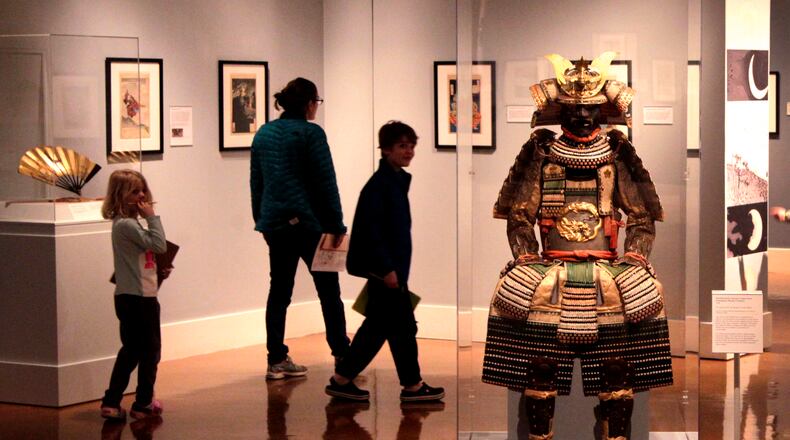This weekend is your last chance. The exhibit is entitled “Samurai, Ghosts, and Lovers: Yoshitoshi’s Complete 100 Aspects of the Moon.” In addition to the 100 original woodblock prints, another 50 works on display will include loans of samurai armor and arms and rarely seen works from the DAI Japanese collection, such as decorative arts and screen and scroll paintings.
The exhibit will close Sunday, Sept. 13.
The DAI exhibit is unusual, thanks to a major donation to the Asian Art Acquisition Fund in honor of the museum’s centennial. Given in memory of Jack and Marilyn Graef by Jack Graef Jr., Linda Stein, Susan Shettler and their families, the donation allowed the museum to purchase a complete set of 100 Japanese color woodblock prints by Yoshitoshi entitled “100 Aspects of the Moon.” According to DAI curators, very few museums in the United States own the entire set and they are rarely displayed because of their light sensitivity.
If you’re fascinated by Japan, you’d be wise to take advantage of the current exhibition. Over the next few months, you can learn a lot about Japanese history and culture by viewing the special exhibit and attending some of the programs associated with the show. They range from screenings of classic Japanese films and a Japanese print demonstration to a talk about the strange and supernatural in Japanese literature and a performance of traditional Japanese instruments.
More about Yoshitoshi
The artist, who lived from 1839-1892, was one of the most prolific and popular print artists of his time. He began his apprenticeship of the ukiyo-e genre of woodblock printing at the age of 11 with a famous artist and was ultimately recognized as the last great master of that genre and one of the form's greatest innovators.
“He was considered the last great print artist at a time when photography was becoming more popular,” explains Peter L. Doebler, the DAI’s Kettering Curator of Asian Art and curator for this exhibition. “He would design the prints and then others would cut the blocks and do the printing. Each of the prints focuses on specific stories of individual people.”
The artist lived during the transition from the Edo period (1615-1868) to the Meiji period (1868-1912), a time of major social, technological and cultural change in Japan. Although he suffered from mental illness and also endured periods of poverty, after 1873 he became more stable and produced many of his great works. The“100 Aspects of the Moon” was completed shortly before his death.
The colorful prints on display are arranged chronologically and incorporate historical and mythical stories and characters from Japan's past ranging from samurai warriors to court ladies. Classical poems and poets are incorporated, often in the title. Here's an example from famed Japanese poet Sugawara no Michizane: "The moon glimmers like bright snow and plum blossoms appear like reflected stars; ah! the golden mirror of the moon passes overhead as fragrance from the jade chamber fills the garden."
An image of the moon is featured in most of the prints. See if the young “Goodnight, Moon” enthusiasts in your family can spot these moons in the various pictures!
“It was always popular in Japan to go out and view the moon at night,” says Doebler. “It was popular to look at cherry blossoms under the moonlight.”
The stories often focus on the emotional conflicts of the characters during transitional times in their lives and incorporate all strata of society and people of all ages, including children. “In many ways, the prints provide a concentrated introduction to 1,000 years of Japanese culture and history organized by epochs,” Doebler says. Each print typically focuses on one character, sometimes a few. Some of the prints include animals and musical instruments such as the Biwa, a lute and Koto, a flat harp.
Take time to read the wall text next to each of the prints and you’ll learn more about each story. You’ll meet a Golden Boy who has been abandoned in the wilderness and raised by a mountain woman, a peasant farmer preparing to kill an important warrior and a distressed lover about to jump into the river.
You’ll appreciate the woodblock prints more if you watch a video, available on www.youtube.com, that explains the tools and process used to make wood blocks.
Art materials in the interactive space will let the whole family design portrait-style illustrations of a favorite character from history or legend and also learn about the components of a print.
The DAI’s gift shop is stocked with a variety of Japanese tableware items, ranging from rice bowls and decorative chopsticks in a variety of traditional patterns to a kimono ladies sake set. A companion booklet for the exhibit includes all 100 prints in the series and a larger, hardcover collector’s edition book features essays about each print. The shop is also offering prints and postcards of selected work, as well as other books related to Japanese art and culture.
Universal appeal
Doebler says he’s hoping this exhibit will appeal to anyone interested in Japanese culture as well as anyone interested in human stories.
“The moon goes through phases but it is always a constant in our life,” he concludes. “Human life is always changing but the moon gives us a sense of something that endures.”
HOW TO GO
What: "Samurai, Ghosts and Lovers," Tsukioka Yoshitoshi's series "100 Aspects of the Moon.
When: Through Sunday, Sept. 13. Gallery hours are 11 a.m. to 5 p.m. Fridays and Saturdays and noon to 5 p.m. Sundays.
Where: Dayton Art Institute, 456 Belmonte Park Drive, Dayton
Tickets: Included in general admission: $15 adults; $10 seniors (60+), active military and groups (10 or more); $5 students (18+ w/ID) and youth (ages 7–17); free for children (ages 6 & younger). Admission is also free for museum members.
About the Author






